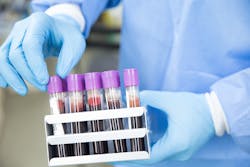Researchers at Stanford University have developed a technology, which they’ve dubbed the “Real-time ELISA,” that is able to perform many blood tests very quickly and then stitch the individual results together to enable continuous, real-time monitoring of a patient’s blood chemistry, according to a press release.
Instead of a snapshot, the researchers end up with something more like a movie.
In a new study, published in the journal Nature Biomedical Engineering, the researchers used the device to simultaneously detect insulin and glucose levels in living diabetic laboratory rats.But the researchers say their tool is capable of so much more because it can be easily modified to monitor virtually any protein or disease biomarker of interest.
Technologically, the system relies upon an existing technology called Enzyme-linked Immunosorbent Assay – ELISA for short. ELISA has been the “gold standard” of biomolecular detection since the early 1970s and can identify virtually any peptide, protein, antibody or hormone in the blood. An ELISA assay is good at identifying allergies, for instance. It is also used to spot viruses like HIV, West Nile and the SARS-CoV-2 coronavirus that causes COVID-19.
The Real-time ELISA is essentially an entire lab within a chip with tiny pipes and valves no wider than a human hair. An intravenous needle directs blood from the patient into the device’s tiny circuits where ELISA is performed over and over.
Real-time, continuous blood monitors have been developed for a few blood markers like glucose, lactate and oxygen, but extending the technology beyond those few examples has proven “exceedingly difficult,” Soh said. This is why the Real-time ELISA’s adaptability to myriad proteins is especially promising.

